Below is the first of two essays nominated in our essay competition “Developments in development”. The other nominated essay will appear on the Node tomorrow. Please read both essays, and come back on or after July 19 to cast your vote for the winner. The winning essay will appear in Development later this year. See the nominee announcement for author bios, and read the second essay here.
An Excitingly Predictable ‘Omic Future
By Joanna Asprer
Developmental biology is an old field of study that finds its origins in the 18th century when Wilhelm Roux ablated cells from the two- or four-cell frog embryos and observed that the remaining cells could not give rise to an entire embryo. It is now more than a century after the publication of that seminal work, and we can attest to the saying that the more things change, the more they stay the same for here we are, still preoccupied with the same issue of stem cell pluripotency.
That matter aside, developmental biology has definitely come a long way. Where before, Roux and his contemporaries sought to study embryonic development through microsurgical manipulation of early embryos, we now alter model organisms on a genetic level, creating knockouts and transgenics, and we routinely analyze them on a molecular level by performing Q-RT-PCRs, ChIP assays, Co-IPs, immunohistochemical analyses and so on.
The most recent additions to our arsenal, the microarray and next gen sequencing, have been so pivotal to the progress of the field that they have ushered in an entirely new era, the ‘omics era. We are no longer limited to the analysis of one or several genes at a time; instead, we attempt to take in the full breadth of the changes that occur as development progresses, starting from the level of organisms, organs, tissues, cells, and molecules, to the level of genomes, epigenomes, and transcriptomes.
Interestingly, the field of developmental biology was slow to incorporate those technologies:
The pre-translational ‘omics era began in 1995 when the laboratory of Patrick Brown published a study about 45 Arabodopsis genes that were analyzed via microarray. The technology was quickly applied by those in the fields of cancer genetics, medical genetics, immunology and even drug development. It was only in 1999 that the first developmental papers studying Drosophila genes via microarray were published.
The lag seemed concordant with the general inaccessibility of the technology in its infancy. In fact, in the 1990s, scientists complained about restricted access to microarray technology, citing high cost, limited availability and patent disputes. Biotech companies responded by adding lower cost arrays to their portfolios, which prior to that mainly catered to industry R and D scientists. Meanwhile, institutions began to build core facilities to make the technology available to more scientists. Today, a Pubmed search using the keywords “microarray and embryonic development” yields close to 2000 results, and this is by no means an exhaustive search of all developmental studies that made use of array technology.
Next gen sequencing technology has also existed in some form as far back as the 1990s when it was only useful to developmental biologists for generating EST libraries. Soon after the technology was commercialized in 2005, it was used to catalog developmental miRNAs in several model organisms, an undertaking that has proven essential for the continued progress of developmental biology. However, medical genetics, cancer genetics, microbiology and virology made much bigger strides while using the same technology. This may be explained by the fact that the technology was primarily designed to sequence genomes and is understandably valuable in fields where there is great genetic variation within sample populations, and where there is a constant supply of new genomes to sequence.
For developmental biologists who make use of isogenic strains of organisms with fully-sequenced genomes, it was the subsequent application of next gen sequencing to the quantitative analysis of gene expression and gene regulation via RNA-seq and ChIP-seq that triggered its complete assimilation into the field. Still, even with the development of more relevant applications of the technique, there are currently under a hundred papers on Pubmed that can be located with the search words “RNA seq” or “ChIP seq” and “embryonic development“. This is again not an exhaustive list, but it gives us an idea that next gen sequencing is not as widespread or accessible as we would like it to be.
Both, next gen sequencing and microarrays are definitely not seen as routine tools on the level of even Q-RT-PCRs, at least not in the typical lab. Often, they are used as screens, performed with great cost and effort once in a blue moon; the intervening time is used to parse through the data and validate a multitude of individual results using more traditional techniques. This trend will continue for some time yet, but we are now at another turning point where the technological advancements with semiconductor chips are allowing us to sequence a human genome in one day for a mere thousand dollars, a far cry from the decade and billions of dollars that were needed to complete the Human Genome Project in the year 2000.
With the growing accessibility of next gen sequencing, more and more labs will do it more and more often. At some point, the affordability of new technologies will take high throughput experiments from the domain of core facilities and give direct, in-lab access to a wider variety of scientists; someday, hopefully soon, we will be able to do the high throughput experiments in our own labs, comparing what makes Cell A different from Cell B, answering questions about how Process C changes the behavior or identity of Cell A, and finding out what DNA or RNA sequences Protein D binds to in order to induce the development of Cell B from Cell A in response to Process C.
Based on what happened in response to the introduction of microarray cores, we can predict that this unparalleled access to high throughput technologies will accelerate progress in the field. True, the democratization of high throughput experiments is bound to bring with it a host of problems associated with inexperience, like misuse of equipment, faulty experimental design or misinterpretation of results. However, with time it will encourage a wider distribution of expertise which, combined with each lab having greater control over the equipment, will allow the execution of more experiments with possibly more complex experimental designs that will allow us to answer questions we could not tackle before.
So much data will be generated in this sequencing revolution that our search for the needle in a haystack will evolve into a search for the critical pieces of information hidden in terabytes of data. As the challenge shifts from data-gathering to data-mining, bioinformatics will be more important than ever before. There will be great demand to recruit bioinformatics experts in order to address developmental issues, and even classical developmental biologists will be compelled to get training if only to be able to design experiments properly and understand their collaborators sufficiently.
With teams of developmental biologists and bioinformatics experts working together, I envision a scenario where we would be able to speed up the process of mapping mutations generated by random mutagenesis using whole genome sequencing. It may be a long while yet before this becomes thinkable in the fly field, but it might already represent an economical alternative to maintaining large mouse colonies for long periods of time while doing segregation analysis.
Along those same lines, many mouse labs have experienced the tragedy of running across a mutant with an exciting phenotype only to observe that the phenotype has low penetrance, or worse, has disappeared with a transition from one genetic background to another. In this situation, it is quite likely that there is a modifier influencing the gene-of-interest. At the moment, we are given only two extreme options: throw in the towel and move on to something more tractable, or bull-headedly and blindly backcross into a defined background or two until the phenotype resurfaces or exhibits itself consistently. Soon we may have the third, fast and productive option of sequencing genomes and finding the genetic change or polymorphism that segregates with the phenotype or the lack thereof. Thus, the lab tragedy can turn into a serendipitous discovery about the pathway the lab is working on.
Clearly, affordable next gen sequencing will be a great boon to basic scientists, but the ‘omics era comes at a time where we are experiencing a strong push for translational or disease-relevant science, courtesy of the grim economic outlook and the corresponding decrease in research funding and the demand for responsible use of public funds. The alignment of technological availability and the renewed thrust towards improving human health will work out very well for the field of medical genetics where the recent launch of whole exome sequencing for diagnostic purposes will reveal novel disease-causing mutations. This development promises to benefit other fields, including ours, as many of the discovered mutations will inevitably affect developmental genes and the human phenotype-genotype correlations will provide a nice complement to the studies done with model organisms.
Meanwhile, in developmental cell biology, great emphasis will continue to be placed on the study of different kinds of stem cells and their differentiation into cells that can be used for therapeutic purposes; this endeavor can benefit from high throughput analyses as well: At present, we rely on one or several markers to characterize pluripotent stem cells or the differentiated cells that we have turned them into, but we know that expression of one gene does not a cell type make. Even our markers tend to be expressed by multiple cell types, all of which represent possible end points of pluripotent stem cell differentiation. Moreover, expression of a certain marker doesn’t guarantee that an induced cell will behave and function exactly like the predicted cell type. Thus, there will be a point when it will be unacceptable to use only a few markers in identifying cells for therapeutic use, and instead transcriptome fingerprinting will be the norm.
I have no doubt that many completely new things will eventually revolutionize our field, but in my opinion, the future of developmental biology lies in the inevitable integration of the great trends that saw their beginnings in the last two decades: It will feature extensive use of next gen sequencing and bioinformatics to elucidate pre-translational ‘omics while finding the etiology of developmental diseases and refining the protocols for regenerative medicine. This may well be considered as a known and fixed future, but its predictability is not one that precedes boredom. For me, this is a future that is as exciting as any unknown development that anyone could imagine.
—–
To vote for Joanna’s essay, go to the poll.
 (15 votes)
(15 votes)
 Loading...
Loading...
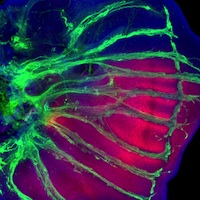 1. 5th instar imaginal hindwing disk from the Painted Lady butterfly, Vanessa cardui. Immunostained for Engrailed in red. All nuclei are revealed by DAPI staining (blue), and trachae are shown in green. This image was taken by Alessandro Mongera, Maria Almuedo Castillo, and Jakub Sedzinski.
1. 5th instar imaginal hindwing disk from the Painted Lady butterfly, Vanessa cardui. Immunostained for Engrailed in red. All nuclei are revealed by DAPI staining (blue), and trachae are shown in green. This image was taken by Alessandro Mongera, Maria Almuedo Castillo, and Jakub Sedzinski.  2. 3rd instar wing disk from Drosophila melanogaster. Triple flip-out clone system (courtesy of Melanie Worley and Iswar Hariharan) was used to reveal various cell lineage clones shown in yellow, blue, and purple. All nuclei shown in gray (DAPI). This image was taken by Lynn Kee.
2. 3rd instar wing disk from Drosophila melanogaster. Triple flip-out clone system (courtesy of Melanie Worley and Iswar Hariharan) was used to reveal various cell lineage clones shown in yellow, blue, and purple. All nuclei shown in gray (DAPI). This image was taken by Lynn Kee. 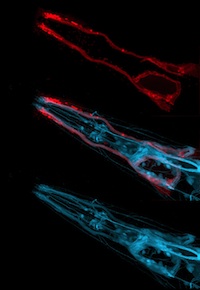 3. Head of an adult C. elegans. DiI staining (red) reveals environmentally exposed neurons, while the JR797 GFP line allows visualization of all neurons (blue). This image was taken by Eric Brooks and John Young.
3. Head of an adult C. elegans. DiI staining (red) reveals environmentally exposed neurons, while the JR797 GFP line allows visualization of all neurons (blue). This image was taken by Eric Brooks and John Young. 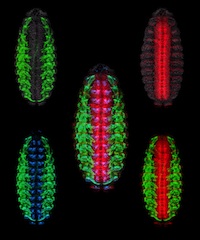 4. Ventral view of stage 16 Drosophila melanogaster embryo immunostained for Tropomyosin (green; muscle), Pax 3/7 (blue; segmentally repeated nuclei in CNS and ectoderm), and anti-HRP (red; cell bodies and axons of the nervous system). All nuclei shown in gray (DAPI). This image was taken by Julieta María Acevedo and Lucas Leclere.
4. Ventral view of stage 16 Drosophila melanogaster embryo immunostained for Tropomyosin (green; muscle), Pax 3/7 (blue; segmentally repeated nuclei in CNS and ectoderm), and anti-HRP (red; cell bodies and axons of the nervous system). All nuclei shown in gray (DAPI). This image was taken by Julieta María Acevedo and Lucas Leclere. 

 (5 votes)
(5 votes) (15 votes)
(15 votes) We’re pleased to announce the nominees of the first
We’re pleased to announce the nominees of the first  (No Ratings Yet)
(No Ratings Yet) Currently, most developmental biologists work on one or more of a relatively small number of experimental systems, such as Arabidopsis thaliana, Drosophila melanogaster (fruit fly), Xenopus laevis (frog), Caenorhabditis elegans (nematode), Danio rerio (zebrafish) and Mus musculus (mouse), and their research is largely focused on understanding developmental mechanisms at the genetic, biochemical and molecular levels. This bias toward certain species is easily understood – analyses in these organisms is greatly facilitated by the availability of an array of genetic, molecular and genomic resources that have been generated over the years by large communities of scientists. However, the field of developmental biology has a long and colourful history of experimentation with a remarkably varied assemblage of creatures, and many crucial discoveries were first made in species that are now relatively understudied. Furthermore, some species possess certain remarkable attributes that have generated interest for a very long time. For example, the axolotl (Ambystoma mexicanum, a Mexican salamander) is considered to be the champion of regeneration among vertebrates, and although the number of people working with axolotls is relatively small, they remain a species of great interest because of the potential breakthroughs that might come from them.
Currently, most developmental biologists work on one or more of a relatively small number of experimental systems, such as Arabidopsis thaliana, Drosophila melanogaster (fruit fly), Xenopus laevis (frog), Caenorhabditis elegans (nematode), Danio rerio (zebrafish) and Mus musculus (mouse), and their research is largely focused on understanding developmental mechanisms at the genetic, biochemical and molecular levels. This bias toward certain species is easily understood – analyses in these organisms is greatly facilitated by the availability of an array of genetic, molecular and genomic resources that have been generated over the years by large communities of scientists. However, the field of developmental biology has a long and colourful history of experimentation with a remarkably varied assemblage of creatures, and many crucial discoveries were first made in species that are now relatively understudied. Furthermore, some species possess certain remarkable attributes that have generated interest for a very long time. For example, the axolotl (Ambystoma mexicanum, a Mexican salamander) is considered to be the champion of regeneration among vertebrates, and although the number of people working with axolotls is relatively small, they remain a species of great interest because of the potential breakthroughs that might come from them.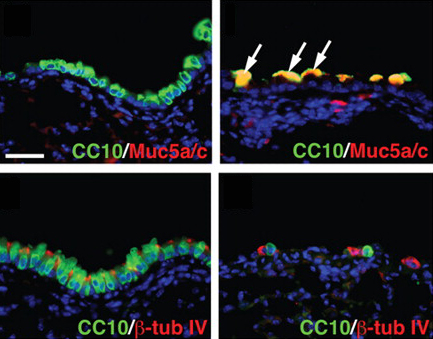
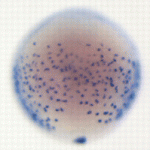 The Hedgehog (Hh) pathway controls both patterning and proliferation during development, but how do embryonic cells distinguish between these activities? On p.
The Hedgehog (Hh) pathway controls both patterning and proliferation during development, but how do embryonic cells distinguish between these activities? On p.  Stem cells are specified and maintained by specific microenvironments called niches. In the Drosophila testis, somatic cyst stem cells (CySCs) give rise to cyst cells, which ensheath the differentiating germline stem cells (GSCs). Both stem cell pools are arranged around a group of somatic cells – the hub – that produce niche signals for both lineages. Now, Christian Bökel and co-workers report that CySC but not GSC maintenance requires Hedgehog (Hh) signalling in addition to Jak/Stat pathway activation (see p.
Stem cells are specified and maintained by specific microenvironments called niches. In the Drosophila testis, somatic cyst stem cells (CySCs) give rise to cyst cells, which ensheath the differentiating germline stem cells (GSCs). Both stem cell pools are arranged around a group of somatic cells – the hub – that produce niche signals for both lineages. Now, Christian Bökel and co-workers report that CySC but not GSC maintenance requires Hedgehog (Hh) signalling in addition to Jak/Stat pathway activation (see p. 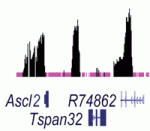 Noncoding RNAs (ncRNAs) help to establish transcriptional gene silencing during development by interacting with DNA and chromatin-modifying enzymes. But do they also help to maintain gene silencing? Here (p.
Noncoding RNAs (ncRNAs) help to establish transcriptional gene silencing during development by interacting with DNA and chromatin-modifying enzymes. But do they also help to maintain gene silencing? Here (p.  Hundreds of microRNAs (miRNAs) – short RNAs that mediate networks of post-transcriptional gene regulation – have been recorded in animals. Because cell-based assays and bioinformatics provide evidence for large numbers of functional targets for individual miRNAs, it is not obvious that manipulation of miRNAs will lead to interpretable phenotypes at the organismal level. However, on p.
Hundreds of microRNAs (miRNAs) – short RNAs that mediate networks of post-transcriptional gene regulation – have been recorded in animals. Because cell-based assays and bioinformatics provide evidence for large numbers of functional targets for individual miRNAs, it is not obvious that manipulation of miRNAs will lead to interpretable phenotypes at the organismal level. However, on p. 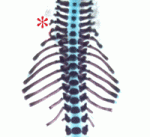 During the development of the vertebrate axial skeleton, Hox genes belonging to paralog group 10 play a role in blocking rib formation in the lumbar region of the vertebral column. Here (p.
During the development of the vertebrate axial skeleton, Hox genes belonging to paralog group 10 play a role in blocking rib formation in the lumbar region of the vertebral column. Here (p.  Epidermal growth factor receptor (EGFR) signalling regulates numerous processes throughout Drosophila development. For example, during oogenesis, an EGFR activation gradient induced by Gurken (a TGFα-like ligand secreted from the oocyte) patterns the follicular epithelium. On p.
Epidermal growth factor receptor (EGFR) signalling regulates numerous processes throughout Drosophila development. For example, during oogenesis, an EGFR activation gradient induced by Gurken (a TGFα-like ligand secreted from the oocyte) patterns the follicular epithelium. On p.  Tissue regeneration has been studied for hundreds of years, yet remains one of the less understood topics in developmental biology. The recent Keystone Symposium on Mechanisms of Whole Organ Regeneration, reviewed by Gregory Nachtrab and Kenneth Poss, brought together biologists, clinicians and bioengineers representing an impressive breadth of model systems and perspectives. See the Meeting Review on p.
Tissue regeneration has been studied for hundreds of years, yet remains one of the less understood topics in developmental biology. The recent Keystone Symposium on Mechanisms of Whole Organ Regeneration, reviewed by Gregory Nachtrab and Kenneth Poss, brought together biologists, clinicians and bioengineers representing an impressive breadth of model systems and perspectives. See the Meeting Review on p. 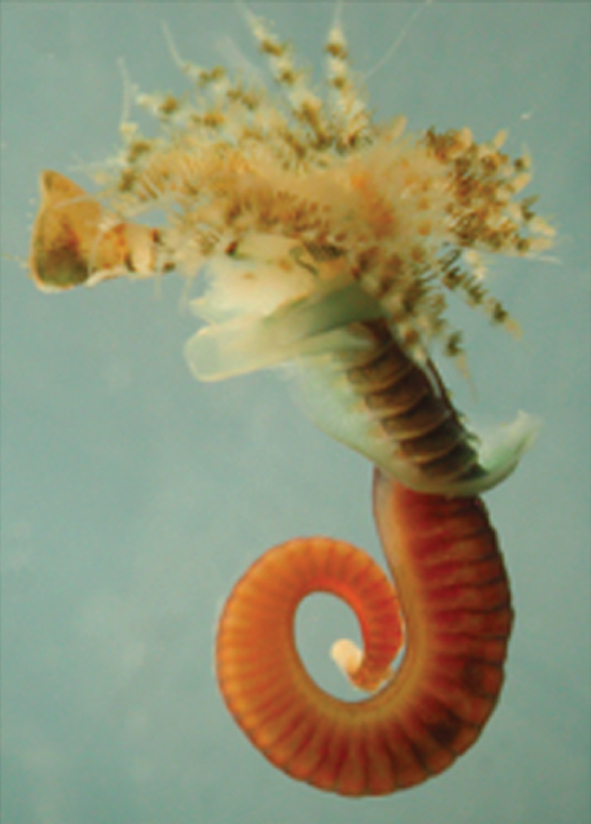 Annelids (the segmented worms) have a long history in studies of animal developmental biology, particularly with regards to their cleavage patterns during early development and their neurobiology. As reviewed by David Ferrier, Annelida are playing an important role in deducing the developmental biology of the last common ancestor of the protostomes and deuterostomes.
Annelids (the segmented worms) have a long history in studies of animal developmental biology, particularly with regards to their cleavage patterns during early development and their neurobiology. As reviewed by David Ferrier, Annelida are playing an important role in deducing the developmental biology of the last common ancestor of the protostomes and deuterostomes.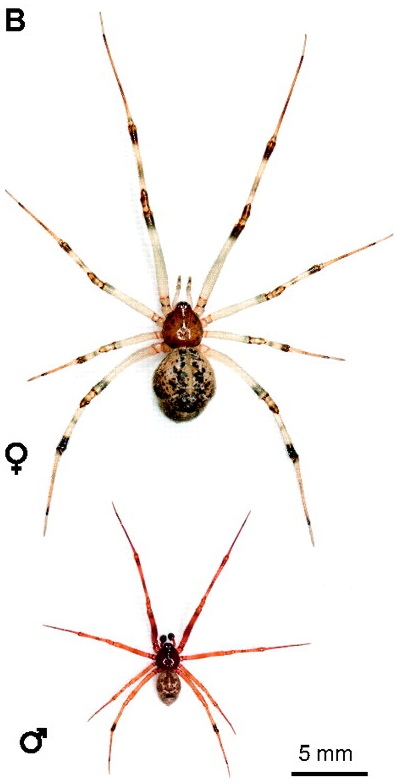 Spiders belong to the chelicerates, which is an arthropod group that branches basally from myriapods, crustaceans and insects. Hilbrant, Damen and McGregor describe how the growing number of experimental tools and resources available to study Parasteatoda development have provided novel insights into the evolution of developmental regulation and have furthered our understanding of metazoan body plan evolution.
Spiders belong to the chelicerates, which is an arthropod group that branches basally from myriapods, crustaceans and insects. Hilbrant, Damen and McGregor describe how the growing number of experimental tools and resources available to study Parasteatoda development have provided novel insights into the evolution of developmental regulation and have furthered our understanding of metazoan body plan evolution.